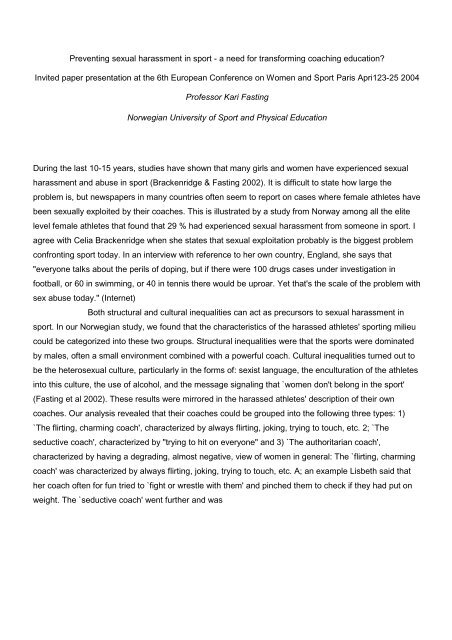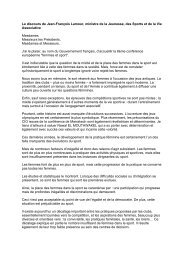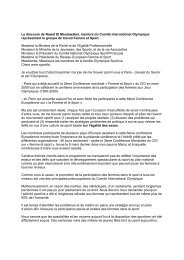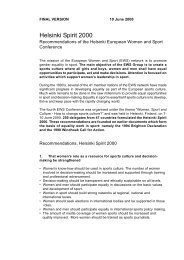Preventing sexual harassment in sport - EWS European Women and ...
Preventing sexual harassment in sport - EWS European Women and ...
Preventing sexual harassment in sport - EWS European Women and ...
You also want an ePaper? Increase the reach of your titles
YUMPU automatically turns print PDFs into web optimized ePapers that Google loves.
<strong>Prevent<strong>in</strong>g</strong> <strong>sexual</strong> <strong>harassment</strong> <strong>in</strong> <strong>sport</strong> - a need for transform<strong>in</strong>g coach<strong>in</strong>g education?Invited paper presentation at the 6th <strong>European</strong> Conference on <strong>Women</strong> <strong>and</strong> Sport Paris Apri123-25 2004Professor Kari Fast<strong>in</strong>gNorwegian University of Sport <strong>and</strong> Physical EducationDur<strong>in</strong>g the last 10-15 years, studies have shown that many girls <strong>and</strong> women have experienced <strong>sexual</strong><strong>harassment</strong> <strong>and</strong> abuse <strong>in</strong> <strong>sport</strong> (Brackenridge & Fast<strong>in</strong>g 2002). It is difficult to state how large theproblem is, but newspapers <strong>in</strong> many countries often seem to report on cases where female athletes havebeen <strong>sexual</strong>ly exploited by their coaches. This is illustrated by a study from Norway among all the elitelevel female athletes that found that 29 % had experienced <strong>sexual</strong> <strong>harassment</strong> from someone <strong>in</strong> <strong>sport</strong>. Iagree with Celia Brackenridge when she states that <strong>sexual</strong> exploitation probably is the biggest problemconfront<strong>in</strong>g <strong>sport</strong> today. In an <strong>in</strong>terview with reference to her own country, Engl<strong>and</strong>, she says that"everyone talks about the perils of dop<strong>in</strong>g, but if there were 100 drugs cases under <strong>in</strong>vestigation <strong>in</strong>football, or 60 <strong>in</strong> swimm<strong>in</strong>g, or 40 <strong>in</strong> tennis there would be uproar. Yet that's the scale of the problem withsex abuse today." (Internet)Both structural <strong>and</strong> cultural <strong>in</strong>equalities can act as precursors to <strong>sexual</strong> <strong>harassment</strong> <strong>in</strong><strong>sport</strong>. In our Norwegian study, we found that the characteristics of the harassed athletes' <strong>sport</strong><strong>in</strong>g milieucould be categorized <strong>in</strong>to these two groups. Structural <strong>in</strong>equalities were that the <strong>sport</strong>s were dom<strong>in</strong>atedby males, often a small environment comb<strong>in</strong>ed with a powerful coach. Cultural <strong>in</strong>equalities turned out tobe the hetero<strong>sexual</strong> culture, particularly <strong>in</strong> the forms of: sexist language, the enculturation of the athletes<strong>in</strong>to this culture, the use of alcohol, <strong>and</strong> the message signal<strong>in</strong>g that `women don't belong <strong>in</strong> the <strong>sport</strong>'(Fast<strong>in</strong>g et al 2002). These results were mirrored <strong>in</strong> the harassed athletes' description of their owncoaches. Our analysis revealed that their coaches could be grouped <strong>in</strong>to the follow<strong>in</strong>g three types: 1)`The flirt<strong>in</strong>g, charm<strong>in</strong>g coach', characterized by always flirt<strong>in</strong>g, jok<strong>in</strong>g, try<strong>in</strong>g to touch, etc. 2; `Theseductive coach', characterized by "try<strong>in</strong>g to hit on everyone" <strong>and</strong> 3) `The authoritarian coach',characterized by hav<strong>in</strong>g a degrad<strong>in</strong>g, almost negative, view of women <strong>in</strong> general: The `flirt<strong>in</strong>g, charm<strong>in</strong>gcoach' was characterized by always flirt<strong>in</strong>g, jok<strong>in</strong>g, try<strong>in</strong>g to touch, etc. A; an example Lisbeth said thather coach often for fun tried to `fight or wrestle with them' <strong>and</strong> p<strong>in</strong>ched them to check if they had put onweight. The `seductive coach' went further <strong>and</strong> was
characterized by try<strong>in</strong>g to "hit on everyone", as Ingrid said "I th<strong>in</strong>k he had as a goal to geteveryone <strong>in</strong>to bed". Accord<strong>in</strong>g to the athletes the `authoritarian coach' was, <strong>in</strong> addition to be<strong>in</strong>gpowerful <strong>and</strong> us<strong>in</strong>g his power, also characterized by hav<strong>in</strong>g psychological/psychic problems <strong>and</strong>often had, <strong>in</strong> addition, a degrad<strong>in</strong>g, almost negative view of women <strong>in</strong> general. "With him it is thathe has this op<strong>in</strong>ion about women that they should keep silent <strong>and</strong> do what they are told. That'sit", said Krist<strong>in</strong>. Some athletes were even given the feel<strong>in</strong>g that women should not participate <strong>and</strong>compete <strong>in</strong> their <strong>sport</strong>.The <strong>European</strong> Parliament Resolution on <strong>Women</strong> <strong>and</strong> Sport adopted last year has a paragraphthat reads as follows:Urges Member States <strong>and</strong> Sport Federations to adopt measures for the prevention <strong>and</strong>elim<strong>in</strong>ation of <strong>sexual</strong> <strong>harassment</strong> <strong>and</strong> abuse <strong>in</strong> <strong>sport</strong> by enforc<strong>in</strong>g the legislation on <strong>sexual</strong><strong>harassment</strong> at work, to <strong>in</strong>form athletes <strong>and</strong> their parents of the risk of abuse <strong>and</strong> the means oflegal action available to them, to provide <strong>sport</strong>s organisations' staff with specific tra<strong>in</strong><strong>in</strong>g <strong>and</strong> toensure that crim<strong>in</strong>al <strong>and</strong> discipl<strong>in</strong>ary provisions are applied.(§ 40)Over the last few years some countries have also done a lot to prevent <strong>sexual</strong><strong>harassment</strong> <strong>and</strong> abuse from occurr<strong>in</strong>g <strong>in</strong> <strong>sport</strong>, particularly, UK, Australia, New Zeal<strong>and</strong>,Canada, USA <strong>and</strong> the Netherl<strong>and</strong>s. A number of codes of conduct have been developed by<strong>sport</strong> <strong>and</strong> political organizations. On request from the Council of Europe's Sport Division a fewyears ago, Celia Brackenridge <strong>and</strong> I analyzed more than 100 codes, policies, <strong>and</strong> other materialsrelat<strong>in</strong>g to ethical practice <strong>in</strong> <strong>sport</strong> <strong>and</strong> leisure. The content analysis of the different nationalcodes of conduct for coaches revealed many common areas, which were not <strong>sport</strong> specific.These central themes were:- issues of responsibility of the coach- issues concern<strong>in</strong>g <strong>in</strong>timate relationships- private life- coach/parent relationship (cooperation with parents)- venues <strong>and</strong> meet<strong>in</strong>g places (be<strong>in</strong>g alone with an athlete)- the language of the coach- touch<strong>in</strong>gAs an example I will just quote a few statements from New Zeal<strong>and</strong>. In the Hillary Commission'sCode of Ethics for Coaches it states that: "You should:- know that you have considerable power over athletes <strong>and</strong> you should not abuse it
- consider how your personal style is seen by those you coach- be aware that unnecessary touch<strong>in</strong>g may offend- be careful about which part of the athlete's body you touch- be aware that what an athlete is wear<strong>in</strong>g may <strong>in</strong>fluence how she/he feels about be<strong>in</strong>gtouched- use appropriate language <strong>and</strong> behaviour- not ask an athlete out on a date- discourage an athletes from attempt<strong>in</strong>g to start an <strong>in</strong>timate relationshipIt is often hypothesized that <strong>sexual</strong> <strong>harassment</strong> is not about <strong>sexual</strong>ity, but about power. Theclassic def<strong>in</strong>ition of power as `power over' or `power as property' is often associated with structural<strong>in</strong>equalities, because the power exists either with<strong>in</strong> an <strong>in</strong>stitution (<strong>sport</strong>) or with<strong>in</strong> an <strong>in</strong>dividual(coach). Structural conceptions of power imply a hierarchy, <strong>in</strong> that there are the powerful (malecoaches) <strong>and</strong> the powerless (female athletes). In relation to leadership <strong>and</strong> coach<strong>in</strong>g it seems thatit is particularly this dogmatic style of authoritarian leadership, that the athletes often are uncritical<strong>and</strong> dedicated too, which have facilitated optimum conditions for <strong>sexual</strong> exploitation <strong>in</strong> <strong>sport</strong>(Brackenridge 2001). This coach<strong>in</strong>g style <strong>and</strong> the behaviour which is imbedded <strong>in</strong> it reflect <strong>sport</strong>as a mascul<strong>in</strong>e doma<strong>in</strong>, generated through the generated <strong>in</strong>stitution of <strong>sport</strong>.So what can we do to change this situation, what can be done so that <strong>sport</strong> becomes a saferenvironment for girls <strong>and</strong> women? How do we change this culture? It should also be mentionedthat <strong>in</strong> most cases, particularly <strong>in</strong> top level <strong>sport</strong> the female athletes are coached my men. Just togive you a few examples from major events: At the 2002 world championships <strong>in</strong> women'svolleyball <strong>in</strong> Germany, <strong>in</strong> which 24 teams participated, all head coaches were men. The situationis similar <strong>in</strong> <strong>in</strong>ternational h<strong>and</strong>ball. At the <strong>European</strong> women's h<strong>and</strong>ball championships, held <strong>in</strong>Denmark <strong>in</strong> 2002, 15 teams were coached by men while only one team had a female coach. Andlook<strong>in</strong>g at the last soccer world championship <strong>in</strong> the USA - 4 of the 16 teams had female coaches.Would it help to br<strong>in</strong>g <strong>in</strong> more female coaches? Would this contribute to a change <strong>in</strong> the cultureof <strong>sport</strong> <strong>and</strong> also <strong>in</strong> the culture of coach<strong>in</strong>g? S<strong>in</strong>ce most abusers are men, one could anticipatethat more female coaches <strong>in</strong> the world of <strong>sport</strong> would reduce the risk of be<strong>in</strong>g harassed. But thatis not sure, because we also know that athletes have been harassed by
female coaches. This may be related to the fact that the women have been educated <strong>in</strong> thesame way as many of their male colleagues <strong>and</strong> accord<strong>in</strong>gly have adopted the sameautocratic coach<strong>in</strong>g style as many men. On the other h<strong>and</strong> a study by Everhart <strong>and</strong>Chelladurai (1998) showed that players who were coached by women perceived lessdiscrim<strong>in</strong>ation <strong>and</strong> were more <strong>in</strong>cl<strong>in</strong>ed to enter coach<strong>in</strong>g than those women coached by men.The authors conclude that these results strongly support the call for hir<strong>in</strong>g more femalecoaches.Coach<strong>in</strong>g education <strong>and</strong> coach<strong>in</strong>g practice seem however to be orientated towards male needs<strong>and</strong> ideal, <strong>and</strong> it can therefore be difficult for women to adapt themselves to male norms <strong>and</strong>values. This is <strong>in</strong> my op<strong>in</strong>ion, one of the reasons for the lack of female coaches, becauseresearch concern<strong>in</strong>g leadership <strong>in</strong> <strong>sport</strong>s shows that the male culture either excludes women ordoes not attract nor accommodate large groups of women (Fast<strong>in</strong>g et a12001). In addition toprevent<strong>in</strong>g <strong>sexual</strong> <strong>harassment</strong> an argument for adopt<strong>in</strong>g another coach<strong>in</strong>g style than theautocratic one can also be used <strong>in</strong> the debate about recruit<strong>in</strong>g more female coaches. But whatk<strong>in</strong>d of coach<strong>in</strong>g style are we talk<strong>in</strong>g about. I will argue for the necessity for coaches to be moredemocratic, but it is more than what often has been called a democratic leadership style. Onealternative is what Celia Brackenridge calls empowerment-based coach<strong>in</strong>g. Empowermentbasedcoach<strong>in</strong>g has redef<strong>in</strong>ed the traditional def<strong>in</strong>ition of power as mentioned earlier (i.e. powerover) <strong>and</strong> def<strong>in</strong>es power as ` energy <strong>and</strong> capacity' <strong>and</strong> uses <strong>sport</strong> as a vehicle to empower theathletes.In a study from Canada of more than 500 athletes <strong>and</strong> about 70 coaches, the reasonsmentioned for why people were reluctant to report <strong>harassment</strong> were:Fear of be<strong>in</strong>g cut from the team 38%Fear of not be<strong>in</strong>g believed 36%Ashamed/embarrassed 51%Loyalty to coach/team 29%Don't know who to talk to 27%Accord<strong>in</strong>g to Celia Brackenridge the exploitation -fear- silence - exploitation cycle is onlybroken when the athlete speaks out, is listened to <strong>and</strong> heard. Giv<strong>in</strong>g voices to the athlete is,then , an essential prerequisite for establish<strong>in</strong>g safety <strong>and</strong> confidence <strong>in</strong> <strong>sport</strong>. To dare tospeak out one must feel safe <strong>and</strong> have self-confidence. The process of empowerment leads toautonomy; <strong>and</strong> with autonomy comes responsibility for self <strong>and</strong> for the consequences of
<strong>in</strong>vest<strong>in</strong>g effort <strong>and</strong> emotion <strong>in</strong>to the embodied dem<strong>and</strong>s of the <strong>sport</strong><strong>in</strong>g performance. Itmay also easier lead to a fulfilment of paragraph 33 <strong>in</strong> The <strong>European</strong> ParliamentResolution on <strong>Women</strong> <strong>and</strong> Sport, which states that: "Urges <strong>sport</strong>swomen to organisethemselves <strong>in</strong> order to defend their <strong>sport</strong><strong>in</strong>g, economic <strong>and</strong> social rights <strong>and</strong> to br<strong>in</strong>gcases of discrim<strong>in</strong>ation <strong>and</strong> <strong>harassment</strong> to the competent authorities or before thecourts". It is only <strong>in</strong>dependent <strong>and</strong> matured, i.e. empowered athletes who will dare to doso.Empowerment strategies may lead athletes to develop the necessary confidence, skills<strong>and</strong> opportunities to resist <strong>sexual</strong> exploitation. It is accord<strong>in</strong>g to Brackenridge more thansimply a matter of personal style. For it to be effective, <strong>and</strong> susta<strong>in</strong>able, the empowermentapproach should permeate the whole ethos of a <strong>sport</strong> organisation <strong>and</strong> its work<strong>in</strong>gpractice. For this to happen education of not only coaches, athletes <strong>and</strong> parents but alsoother people <strong>in</strong>volved <strong>in</strong> <strong>sport</strong> is a necessity.I would also like to state that there are dozens of examples of coaches who are committedto empowerment-based coach<strong>in</strong>g, just to mention a couple that some of you may know: PiaNilsson from Sweden <strong>and</strong> Marit Breivik from Norway. I would like to close this <strong>in</strong>troductionby show<strong>in</strong>g you the recommendations for m<strong>in</strong>imis<strong>in</strong>g the risk of <strong>sexual</strong> exploitation <strong>in</strong> <strong>sport</strong>that <strong>Women</strong>Sport International has put up <strong>in</strong> their new position statement on <strong>sexual</strong><strong>harassment</strong> of Girls <strong>and</strong> <strong>Women</strong> <strong>in</strong> Sport. As you will see implicit <strong>in</strong> these is thedevelopment of an empowerment approach to <strong>sport</strong>.- adopt <strong>harassment</strong>-free policies <strong>and</strong> procedures that are <strong>in</strong> l<strong>in</strong>e with<strong>in</strong>ternational ethical <strong>and</strong> human rights statutes <strong>and</strong> that are <strong>in</strong>clusive;- encourage open debate about <strong>sexual</strong> <strong>harassment</strong>, homophobia <strong>and</strong>exploitation of women <strong>and</strong> men <strong>in</strong> <strong>sport</strong>;- embed both an equitable balance of males <strong>and</strong> females <strong>in</strong> all roles <strong>and</strong>also democratic leadership styles to mitigate aga<strong>in</strong>st abuses of power;- act as advocates of <strong>harassment</strong>-free <strong>sport</strong> through education <strong>and</strong>tra<strong>in</strong><strong>in</strong>g programs for every member of the <strong>sport</strong>;- actively monitor the effectiveness of all anti-<strong>harassment</strong> <strong>in</strong>itiatives;- <strong>in</strong>itiate research <strong>in</strong>to men's, women's <strong>and</strong> children's experiences of abuse<strong>and</strong> bully<strong>in</strong>g with<strong>in</strong> their <strong>sport</strong>;- give active representation to athletes <strong>in</strong>decision-mak<strong>in</strong>g at every level ofthe <strong>sport</strong>References
Speak Out...Act Now (1998). A guide to <strong>Prevent<strong>in</strong>g</strong> <strong>and</strong> Respond<strong>in</strong>g to Abuse<strong>and</strong> Harassment for Sport Clubs <strong>and</strong> Associations, Sport CanadaFast<strong>in</strong>g, K. Brackenridge, C. Sundgot-Borgen, J.(2000) Females, Elite Sports <strong>and</strong>Sexual Harassment. The Norwegian <strong>Women</strong>'s Project, Norwegian Olympic Committee<strong>and</strong> Confederation of Sports, Oslo, NorwayBrackenridge, C. & Fast<strong>in</strong>g, K. (1999) An Analysis of Codes of Practice for <strong>Prevent<strong>in</strong>g</strong>Sexual Harassment <strong>and</strong> Abuse to <strong>Women</strong> <strong>and</strong> Children <strong>in</strong> Sport. Paper prepared forthe Council of Europe Sport Division 1999Brackenridge, C.H. (2001) Spoil<strong>sport</strong>s: Underst<strong>and</strong><strong>in</strong>g <strong>and</strong> prevent<strong>in</strong>g <strong>sexual</strong>exploitation <strong>in</strong> <strong>sport</strong>, London, RoutledgeFast<strong>in</strong>g, K., Brackenridge, C. &, Walseth, K. Sexual harass<strong>in</strong>g coaches. Paperpresented at NASSS Annual Conference, October 29 to November 1, Montreal, CanadaFast<strong>in</strong>g et al (2002) Brisbane<strong>European</strong> Parliament Resolution on <strong>Women</strong> <strong>and</strong> Sport






